Joachim Patinir
Joachim Patinir, also called Patenier (c. 1480 – 5 October 1524), was a Flemish Renaissance painter of history and landscape subjects. He was Flemish, from the area of modern Wallonia,[1] but worked in Antwerp, then the centre of the art market in the Low Countries. Patinir was a pioneer of landscape as an independent genre and he was the first Flemish painter to regard himself primarily as a landscape painter. He effectively invented the world landscape, a distinct style of panoramic northern Renaissance landscapes which is Patinir's important contribution to Western art.
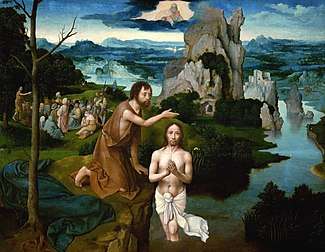

There are only five paintings signed by Patinir, but many other works have been attributed to him or his workshop with varying degrees of probability. The ones that are signed read: (Opus) Joachim D. Patinier, the "D" in his signature signifying Dionantensis ("of Dinant"), reflecting his place of origin. The 2007 exhibition at the Museo del Prado in Madrid contained 21 pictures listed as by Patinir or his workshop, and catalogued a further eight which were not in the exhibition.[2]
Patinir was the friend of not only Dürer, but with Quentin Metsys as well, with whom he often collaborated. The Temptation of St Anthony (Prado) was done in collaboration with Metsys, who added the figures to Patinir's landscape. His career was nearly contemporary with that of the other major pioneer of paintings dominated by landscape, Albrecht Altdorfer, who worked in a very different style. He was probably the uncle of Herri met de Bles, who was his follower in establishing the world landscape.[3]
Life and work

Originally from Dinant or Bouvignes in present-day Belgium, Wallonia, Patinir became registered as a member of Antwerp's painters' guild Guild of Saint Luke in 1515, where he spent the rest of his life. He may have studied with Gerard David at Bruges, who had been registered as a guild member in the same year as Patinir. In 1511, Patinir is believed to have travelled to Genoa with David and Adrien Ysenbrandt.
In 1521, Patinir's friend Albrecht Dürer attended his second wedding and painted his portrait. Dürer called Patinir "der gute Landschaftsmaler" ("the good painter of landscapes"), thus creating a neologism translated later into the French. Patinir often let his landscapes dwarf his figures, which are of very variable quality. The larger ones were at least sometimes painted by other artists.[4] Such specialisation had become common in the Low Countries at the time. Many of his works are unusually large for Netherlandish panel paintings of the time, as are those of Hieronymus Bosch, another painter of large landscapes, from a generation earlier.
Patinir's immense vistas combine observation of naturalistic detail with lyrical fantasy. The steep outcrops of rocks in his landscapes are more spectacular versions of the group of very individual formations just around his native Dinant; these became a part of the world landscape formula, and are found in the works of many painters who never saw the originals. His landscapes use a high viewpoint with a high horizon, but his grasp of aerial perspective is far from complete. He uses a consistent and effective colour scheme in his landscapes, which was influential on later landscape painting. The foreground is dominated by brownish shades, while "the middle ground [is] a bluish green and the background a pale blue", creating an effective sense of recession into the distance; "When combined with the frequently hard-toned browns, greens and blues that alternate with significant areas of white, a sense of impending doom is created by the threatening clouds, the capricious and sharply pointed contours of the rocks and the crowding together of natural elements."[5]
Examples of his work include The Rest on the Flight into Egypt (Prado, which has four Patinirs, including two signed ones), The Baptism of Christ (one of two in Vienna), St. John at Patmos (by or with his workshop, National Gallery, London), Landscape with the Shepherds (Antwerp), and the Rest on the Flight to Egypt (Minneapolis Institute of Arts). Noticeable is the case of The rest on the flight into Egypt, his most repeated at least of what in our days remain of his ouvre, with at least 7 versions including the one preserved at the Thyssen-Bornemisza Museum[6] in Madrid. As a matter of fact the spanish capital holds the most extensive collection of Works by Patinir, with four in The Prado and The Thyssen-Bornemisza and The Royal Monastery of El Escorial owning one each. There is also a triptych attributed to him called The Penitence of St. Jerome.[7] at The Metropolitan Museum of Art in New York.
Patinir died in Antwerp in 1524, and Quentin Metsys became the guardian of his children.
Works
.jpg) Portraits: a drawing by Durer, and a posthumous print by Cornelius Cort
Portraits: a drawing by Durer, and a posthumous print by Cornelius Cort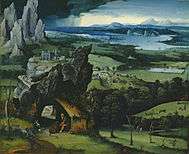 Landscape with St Jerome, 1515–1519, oil on panel, 74 × 91 cm (29.1 × 35.8 in), Museo del Prado, Madrid, Spain
Landscape with St Jerome, 1515–1519, oil on panel, 74 × 91 cm (29.1 × 35.8 in), Museo del Prado, Madrid, Spain Landscape with St John the Baptist Preaching, oil on oak, 36.5 × 45 cm (14.1 × 17.1 in), Royal Museums of Fine Arts of Belgium
Landscape with St John the Baptist Preaching, oil on oak, 36.5 × 45 cm (14.1 × 17.1 in), Royal Museums of Fine Arts of Belgium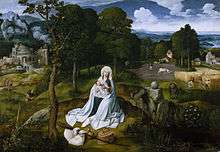 Rest on the Flight into Egypt, oil on panel, 121 × 177 cm (47.6 × 69.7 in), Museo del Prado, Madrid, Spain
Rest on the Flight into Egypt, oil on panel, 121 × 177 cm (47.6 × 69.7 in), Museo del Prado, Madrid, Spain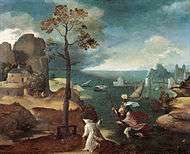 St Christopher Bearing the Christ Child, oil on panel, 48 × 59.5 cm (18.9 × 23.4 in), Rockoxhuis, Antwerp, Belgium
St Christopher Bearing the Christ Child, oil on panel, 48 × 59.5 cm (18.9 × 23.4 in), Rockoxhuis, Antwerp, Belgium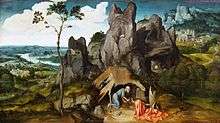 St Jerome in the Desert, c. 1520, oil on panel, 78 × 137 cm (30.7 × 53.9 in), Louvre, Paris
St Jerome in the Desert, c. 1520, oil on panel, 78 × 137 cm (30.7 × 53.9 in), Louvre, Paris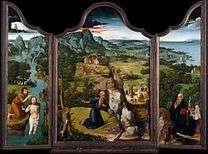 The Penitence of Saint Jerome, c. 1512–15, triptych, oil on wood, 117.5 × 81.3 cm (46.5 × 31.9 in), each wing 120.7 × 35.6 cm (47.5 × 14 in), Metropolitan Museum of Art, New York
The Penitence of Saint Jerome, c. 1512–15, triptych, oil on wood, 117.5 × 81.3 cm (46.5 × 31.9 in), each wing 120.7 × 35.6 cm (47.5 × 14 in), Metropolitan Museum of Art, New York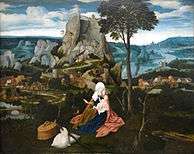
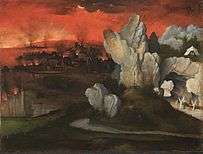 Landscape with the Destruction of Sodom and Gomorrah, c. 1520, oil on panel, 22.5 × 308 cm (8.9 × 11.8 in), Museum Boijmans Van Beuningen
Landscape with the Destruction of Sodom and Gomorrah, c. 1520, oil on panel, 22.5 × 308 cm (8.9 × 11.8 in), Museum Boijmans Van Beuningen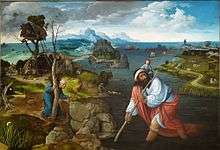 Landscape with Saint Christopher, c. 1520, oil on panel, 125 cm × 170 cm (49.2 × 66.9 in), El Escorial, Monasterio de San Lorenzo, Spain
Landscape with Saint Christopher, c. 1520, oil on panel, 125 cm × 170 cm (49.2 × 66.9 in), El Escorial, Monasterio de San Lorenzo, Spain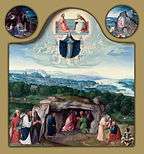 The Assumption of the Virgin, with the Nativity, the Resurrection, the Adoration of the Magi, the Ascension of Christ, Saint Mark and an Angel, and Saint Luke and an Ox, c. 1510–20, oil on panel, 62.28 × 58.7 cm (24.52 × 23.13 in), Philadelphia Museum of Art[8]
The Assumption of the Virgin, with the Nativity, the Resurrection, the Adoration of the Magi, the Ascension of Christ, Saint Mark and an Angel, and Saint Luke and an Ox, c. 1510–20, oil on panel, 62.28 × 58.7 cm (24.52 × 23.13 in), Philadelphia Museum of Art[8]
See also
- Early Renaissance painting
- Renaissance in the Netherlands
Notes
- (in French) Les rochers par lesquels l'art gothique suggère conventionnellement un site sauvage et désertique, sont présents. Comme d'aucuns l'ont remarqué, ces pics rocheux qui vont devenir chez Patinier, indissociables de l'évocation d'un paysage ressemblent à ceux qu'il a pu voir dans la région dinantaise [...] Mais il va de soi que les paysages représentés ne sont jamais dans leur ensemble la transposition de sites existants. L'espace tel que le conçoit Patinier est d'un autre ordre que celui qui s'offre au spectateur dans la réalité.From "L'essor du paysage" in Jacques Stiennon, Jean-Patrick Duchesne, Yves Randaxhe, Cinq siècles de peinture en Wallonie, Les éditeurs d'art associés, Brussels, 1988, pp. 67–72.The landscape of the Mosan valley was the inspiration for Patinir, but the result of this inspiration was not a painting of this landscape.
- Prado feature, exhibition "Patinir", 2007, Museo del Prado, Madrid, Spain.
- Though de Bles was only 14 when Patiner died
- Grove
- Grove
- "Landscape with the Rest on the Flight into Egypt". Museo Nacional Thyssen-Bornemisza. Retrieved 17 September 2019.
- "List of works in the Prado exhibition, 2007". Museodelprado.es. 15 September 2009. Retrieved 19 March 2014.
- Atkins, Christopher D. M. "The Assumption of the Virgin, with the Nativity, the Resurrection, the Adoration of the Magi, the Ascension of Christ, Saint Mark and an Angel, and Saint Luke and an Ox by Joachim Patinir (cat. 378)". The John G. Johnson Collection: A History and Selected Works. A Philadelphia Museum of Art free digital publication.
References
- "Grove": Hans Devisscher. "Patinir, Joachim." Grove Art Online. Oxford Art Online. Oxford University Press. Web. 17 Feb. 2017. subscription required
- Koch, Robert A. Joachim Patinir (Princeton: Princeton University Press, 1968).
- Battistini, Matilde. Symbols & Allegories in Art: The Hereafter. Los Angeles: The J. Paul Getty Museum, 2005. 210, 212–13.
- Falkenburg, Reindert. Joachim Patinir: Landscape as an Image of the Pilgrimage of Life. Amsterdam/Philadelphia: John Benjamins Publishing Company, 1988.
- Ball-Krückmann, Babette, Landschaft zur Andacht: die Weltlandschaften Joachim Pateniers. Munich 1977 (microfiche)
- Pioch, Nicolas. "The Northern Renaissance (1500–1615)." WebMuseum. 14 October 2002. 28 March 2006.
- Smith Chipps, Jeffery. The Northern Renaissance. Phaidon. Arts & Ideas, 2004. 321.
External links
| Wikimedia Commons has media related to Joachim Patinir. |